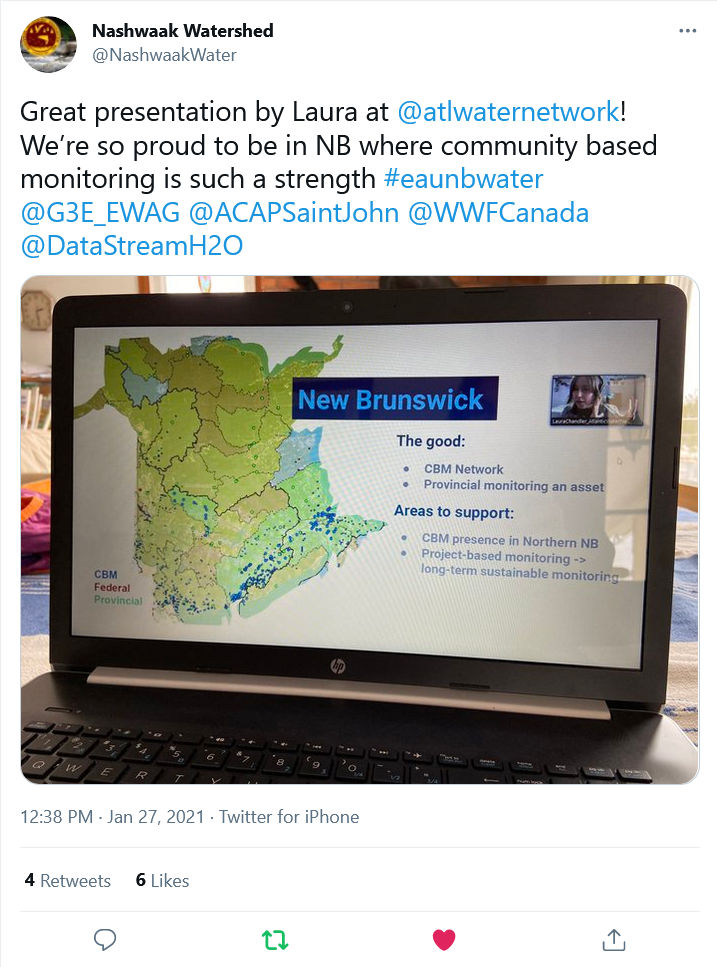Image above: The Portapique River in Nova Scotia where salmon eggs have been introduced in-stream to increase the population of endangered Inner Bay of Fundy (iBoF) Atlantic Salmon. The Maritime Aboriginal Peoples Council (MAPC) are monitoring water quality to identify areas of habitat concern for this culturally and environmentally significant species. Photo by Aislin Livingstone for Atlantic Water Network.
Water data in Atlantic Canada is in short supply. Or is it?
Atlantic Water Network’s partnership with The Gordon Foundation has upped the region’s data ante by bringing DataStream – an open access online hub for water data – to Atlantic Canada. Atlantic DataStream now has over 2.5 million water monitoring observations available for use in watershed assessment and reporting. Yet, WWF-Canada’s 2020 Watershed Report showed that 6 out of 13 sub-watersheds in Atlantic Canada still lack sufficient data required to assign a water quality health score.
What does this tell us?
The presence of long-standing monitoring programs and the availability of large datasets do not always reflect practical local realities. Sufficient water data often coincides with populated areas, leaving more remote water bodies under-monitored.
On the east coast, communities play a big role in filling critical data and information gaps. Over the past year, Atlantic Water Network’s Laura Chandler has been digging through the vast amounts of data available on Atlantic DataStream to pinpoint where the greatest regional supports are needed to fill data gaps. She hosted small, Provincial online conversations to explore regional data gaps and ground-truth them with people who have boots-on-the-ground experience in their region.

The findings are not surprising: watersheds with strong community-based water monitoring networks and consistent provincial monitoring offer more than enough data to support a holistic view of watershed health. On the other hand, watersheds in rural areas and those with inconsistent funding opportunities are in need of support. For instance, Over 3000 monitoring locations have recently recorded data in Atlantic DataStream, but only 16% of them can be labeled as ‘sufficient’ (most of which are coming from Indigenous and community-based monitoring groups). With numbers like these, further digging needs to be done.
Finding the most pressing data gaps was just the first step in shaping strategies to engage individuals and communities in meaningful water quality monitoring. Longer processes of capacity building, securing long-term funding, and coordination are needed to ensure sufficient data can be collected for the long haul. As a network, AWN can not resolve these root issues, but they can support the big questions: how can environmental organizations work together to ensure there is enough coordinated water quality data in these watersheds? What keeps organizations from collecting water quality data or sharing data online, and how can we overcome these barriers together?
Communities can help fill data gaps.
At AWN’s January network-wide meeting, 75 community partners identified valuable considerations for targeting regional outreach in the coming year. Conversations spurred collaboration and creativity in addressing regional data gaps

Illustrations by Libby Dean for Atlantic Water Network’s
2021 Community Partner Meeting (modified).
With new collaborations set up, those currently collecting data can get on the same page about what data they collect. However, it is clear that new organizations need more direction. AWN is providing one-on-one support to new organizations to make sure that the location, frequency, and diversity of data collected will qualify as ‘sufficient data’.
This is part of AWN’s ongoing work to build relationships with diverse and passionate regional partners and help sustain critical local monitoring efforts that get accessible data in the hands of communities and decision-makers.
Atlantic Water Network is a hub for community-based water monitoring throughout Atlantic Canada, collaborating with over 80 organizations to advance water science and stewardship in the region. AWN has been a catalyst and support system for local groups, providing water monitoring equipment, standardized training, data management support, and workshops on data management, analysis, and science communication.
For more information, contact Atlantic Water Network at environmental.network@smu.ca.